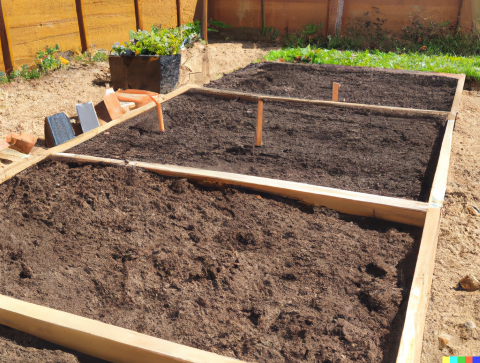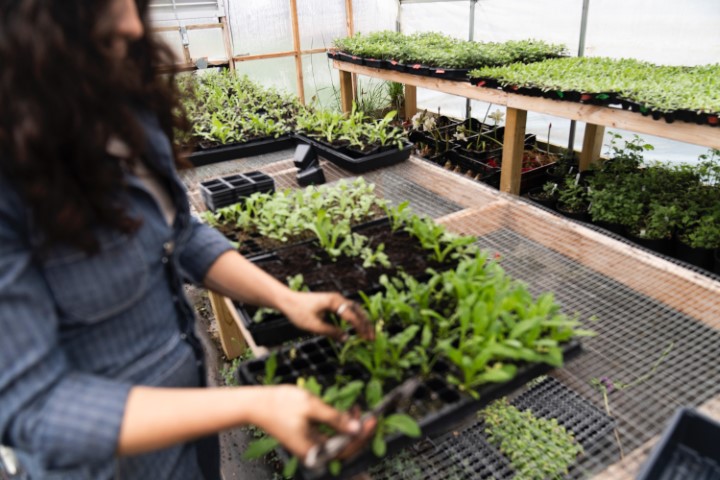Grow Your Own Produce with These Low-Cost Raised Garden Bed Ideas

If you’re looking to start a garden but don’t have a lot of space or a big budget, a raised garden bed can be a great solution. Not only do they provide a contained space for your plants to grow, but they can also be easier on your back since you won’t have to bend down as far to tend to your plants.
Here are some inexpensive raised garden bed ideas to get you started:


How to use Pallets for garden beds?
Using pallets to create a garden-raised bed is a great way to upcycle and repurpose an item that might otherwise be discarded. Here are the steps to follow to make a pallet garden bed:
Find the right pallet:
Look for a pallet that is in good condition, with no broken boards or nails sticking out. Avoid pallets that have been treated with chemicals, as they may leach into your soil.
Cut the pallet:
Cut the pallet in half lengthwise to create two equal pieces using a saw. You can also use the full pallet for a larger garden bed.

Prepare the pallet:
Sand any rough edges or splinters on the pallet, and make sure all the nails are hammered in flush.
Line the pallet:
Line the inside of the pallet with landscaping fabric or cardboard to prevent soil from falling through the slats. Secure the fabric or cardboard in place with staples or nails.
Fill with soil:
Fill the pallet with a nutrient-rich soil mix, leaving about an inch of space at the top.
Plant your garden:
You’re ready to start planting! Choose plants that will thrive in your local climate and sunlight conditions.
Water and maintenance:
Make sure to water your plants regularly and watch for pests or diseases. As your plants grow, add more soil as needed to keep the roots covered.
Using pallets to create a raised garden bed is an easy and affordable way to start your own backyard garden. Not only is it good for the environment, but it’s also a fun and rewarding DIY project.

How to use a Cinder block for garden bed?
Cinder blocks are a popular and affordable material for building a garden bed. Here are the steps to follow to make a cinder block garden bed:
Choose your location:
Select a sunny spot in your yard for your garden bed. Make sure the area is level and has good drainage.
Calculate the number of blocks:
Determine the size of your garden bed and calculate how many cinder blocks you will need. For a standard 8-foot by 4-foot garden bed, you will need 32 cinder blocks.
Lay out the blocks:
Lay out the cinder blocks in the shape of your garden bed. Stack the blocks in rows, making sure to alternate the direction of the blocks for stability.
Secure the blocks:
Once you have the blocks laid out, secure them in place using construction adhesive. This will help keep the blocks from shifting or falling over.
Fill the bed:
Fill the bed with a nutrient-rich soil mix, leaving about an inch of space at the top.
Plant your garden:
Now you’re ready to start planting! Choose plants that will thrive in your local climate and sunlight conditions.
Water and maintenance:
Water your plants regularly and keep an eye out for pests or diseases. As your plants grow, add more soil as needed to keep the roots covered.
Building a cinder block garden bed is an easy and affordable way to create a raised garden bed in your backyard. The blocks are durable, long-lasting, and require little maintenance. Plus, they provide a sturdy structure for your plants to grow in.
How to use Straw bales as garden beds?
Straw bales are an inexpensive and easy-to-use material for creating a garden bed. Here are the steps to follow to make a straw bale garden bed:
Choose your location:
Select a sunny spot in your yard for your garden bed. Make sure the area is level and has good drainage.
Get your straw bales:
Purchase straw bales from a local farm or garden centre. Make sure to get bales that are tightly packed and free of mould.
Condition the bales:
Before you can plant in the straw bales, you need to “condition” them. This involves watering and fertilizing the bales for about a week to jumpstart the decomposition process.
Prepare the bales:
Once the bales are conditioned, poke holes in the top of each bale and fill the gaps with a nutrient-rich soil mix. You can also add compost or other organic matter to the top of the bales to help provide additional nutrients.
Plant your garden:
Now you’re ready to start planting! Choose plants that will thrive in your local climate and sunlight conditions.
Water and maintenance:
Water your plants regularly and keep an eye out for pests or diseases. As your plants grow, you may need to add more soil or compost to the top of the bales to provide additional nutrients.
Using straw bales to create a garden bed is an easy and affordable way to start a garden. The bales are lightweight and easy to move, making them an excellent option for renters or those with limited space. Plus, they provide a natural composting environment for your plants.
What is Galvanized trough, and how to use it for a garden bed?
A galvanized trough is a large metal container, typically made of steel, that has been coated with a layer of zinc to prevent rust and corrosion. Here are the steps to follow to use a galvanized trough for a garden bed:
Choose your location:
Select a sunny spot in your yard for your garden bed. Make sure the area is level and has good drainage.
Prepare the trough:
If your trough still needs to be drilled with drainage holes, use a drill to make several holes in the bottom to allow excess water to drain. You can also line the bottom of the trough with rocks or gravel to help with drainage.
Fill the trough:
Fill the trough with a nutrient-rich soil mix, leaving about an inch of space at the top.
Plant your garden:
Now you’re ready to start planting! Choose plants that will thrive in your local climate and sunlight conditions.
Water and maintenance:
Water your plants regularly and keep an eye out for pests or diseases. You may need to add more soil to the trough as your plants grow to keep the roots covered.
Using a galvanized trough for a garden bed is a great option for those who want a more durable and long-lasting solution. The metal construction is sturdy and will last for many years with proper care. Plus, the trough can be easily moved around your yard or patio to find the perfect location for your plants.

How to use reclaimed wood for garden beds?
Using reclaimed wood for a garden bed is a sustainable and eco-friendly option. Here are the steps to follow to make a garden bed using reclaimed wood:
Choose your location:
Select a sunny spot in your yard for your garden bed. Make sure the area is level and has good drainage.
Get your reclaimed wood:
Look for discarded wood pallets or old fence boards that you can repurpose for your garden bed. Make sure the wood is untreated and free of any chemicals or contaminants.
Prepare the wood:
If using wood pallets, dismantle them and remove any nails or staples. Cut the wood to the desired length and sand the edges to prevent splinters.
Build the bed:
Use the reclaimed wood to build the sides of your garden bed. You can nail or screw the boards together to create a sturdy structure.
Line the bed:
Line the bed with landscape fabric or cardboard to prevent the soil from spilling out between the boards.
Fill the bed:
Fill the bed with a nutrient-rich soil mix, leaving about an inch of space at the top.
Plant your garden:
Now you’re ready to start planting! Choose plants that will thrive in your local climate and sunlight conditions.
Water and maintenance:
Water your plants regularly and keep an eye out for pests or diseases. As your plants grow, you may need to add more soil to the bed to keep the roots covered.
Using reclaimed wood for a garden bed is a great way to repurpose old materials and reduce waste. Plus, the natural look of the wood can add a rustic and charming element to your garden.





